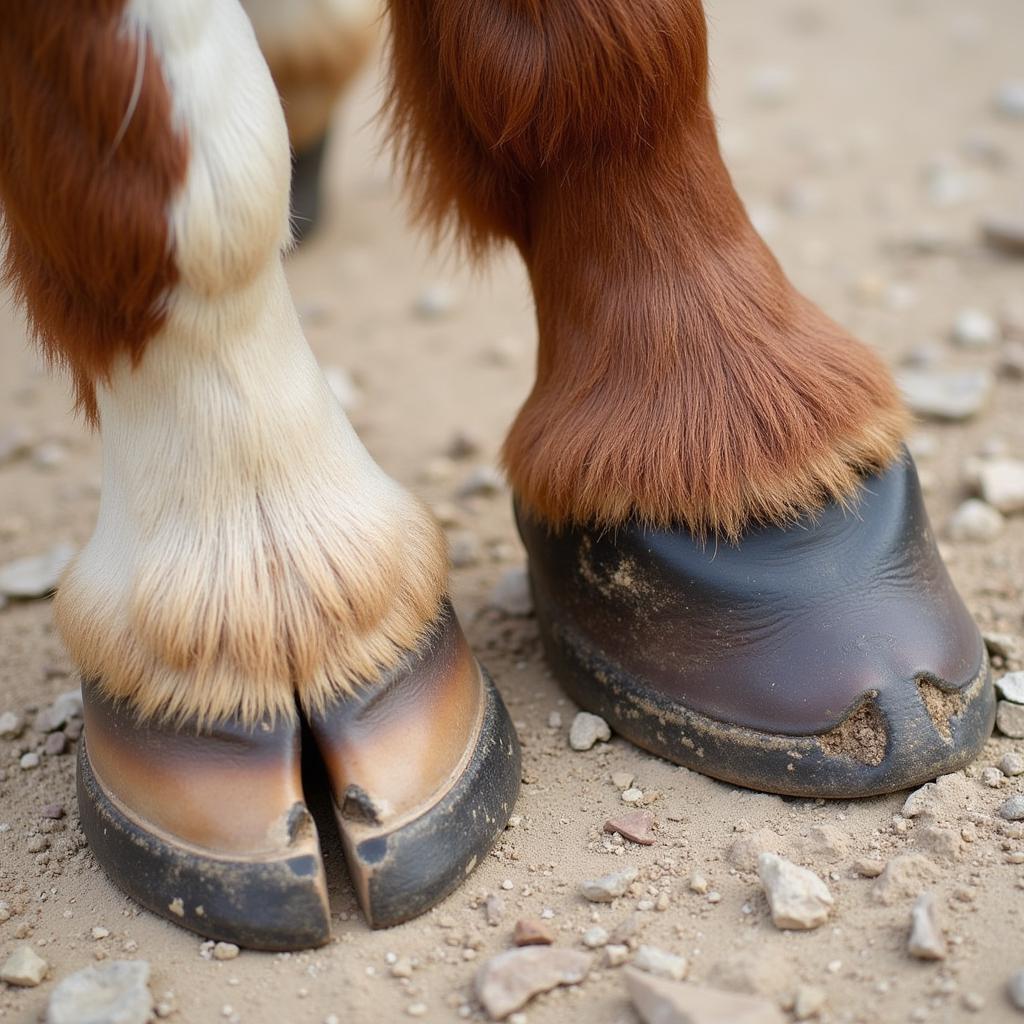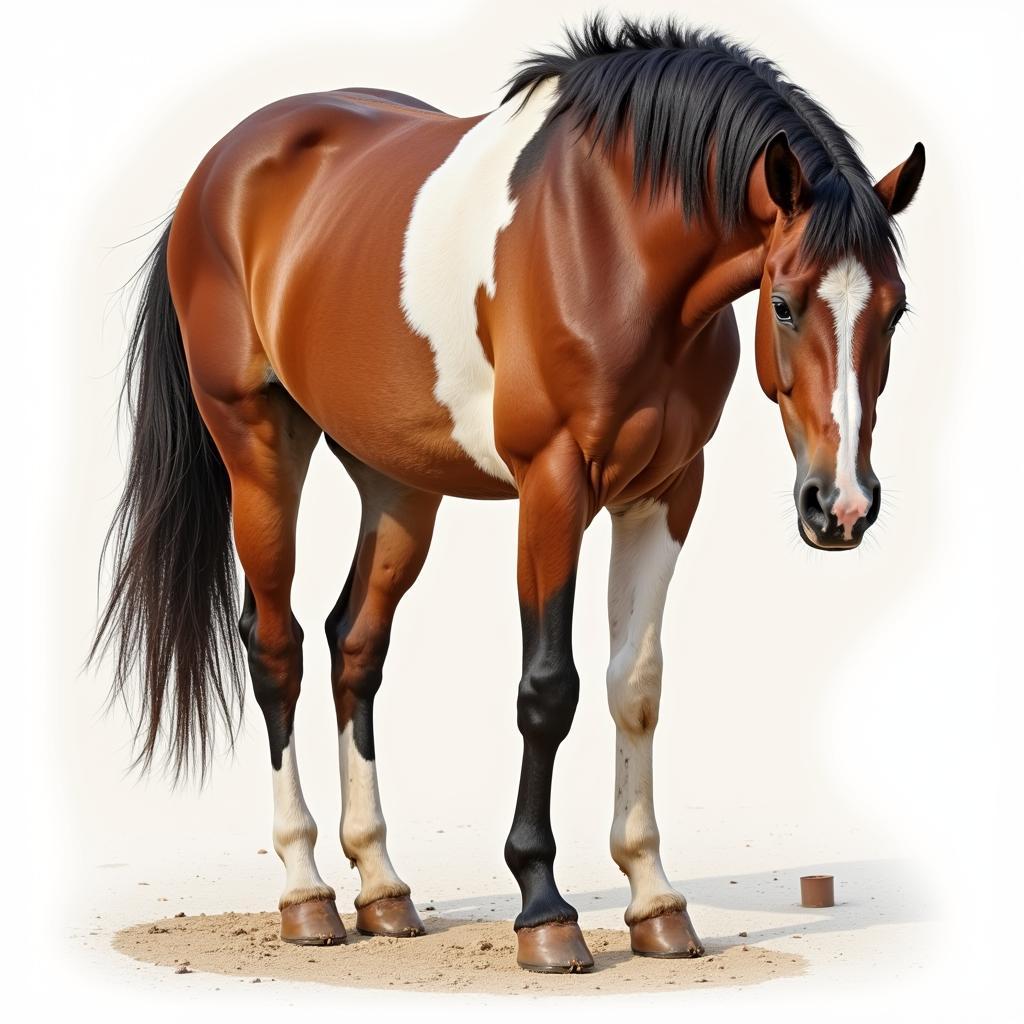Flat Feet In Horses, a condition affecting the shape and structure of the hoof, can significantly impact a horse’s soundness and performance. This article will delve into the causes, symptoms, diagnosis, and management of flat feet, equipping horse owners with the knowledge to provide optimal care.
Horses with flat feet often exhibit a broader, flatter sole with a reduced concavity. This can lead to increased pressure on the sole, bruising, and sensitivity, especially on hard or uneven surfaces. Recognizing the signs and understanding the contributing factors is crucial for effective management.  Flat Horse Feet Showing Sole
Flat Horse Feet Showing Sole
What Causes Flat Feet in Horses?
Several factors can contribute to the development of flat feet. Genetics plays a significant role, with some breeds predisposed to this conformation. Nutritional imbalances, particularly deficiencies in key minerals like copper and zinc, can also weaken hoof structure. Furthermore, improper trimming and shoeing practices can exacerbate or even cause flat feet. For instance, leaving the heels too low can flatten the sole over time. Finally, environmental factors such as consistently wet or soft footing can contribute to weak hooves.
Recognizing the Signs of Flat Feet
Identifying flat feet often involves visual inspection of the hoof. Look for a wide, flat sole with minimal concavity. The hoof wall may appear flared, and the white line may be stretched or widened. Horses with flat feet may exhibit lameness, particularly on hard ground, and may be reluctant to move freely. They might also show signs of discomfort when pressure is applied to the sole.  Horse Showing Lameness and Signs of Flat Feet
Horse Showing Lameness and Signs of Flat Feet
Diagnosing and Managing Flat Feet
If you suspect your horse has flat feet, consult with a veterinarian or a qualified farrier. They can perform a thorough evaluation, including examining the hoof and assessing the horse’s gait. Radiographs may be necessary to assess the internal structures of the hoof.
Managing flat feet typically involves a combination of corrective trimming and shoeing, along with addressing any underlying nutritional deficiencies. Therapeutic shoeing, using specialized shoes or pads, can help redistribute weight and protect the sole. Regular trimming is crucial to maintain proper hoof balance and encourage healthy hoof growth. Supplementation with essential minerals, as recommended by a veterinarian, can strengthen hoof structure over time. In addition, managing the horse’s environment by providing dry, firm footing can contribute to improved hoof health. You might consider how to prevent ice balls in horses feet during colder months, as this can exacerbate existing hoof issues.
Corrective Trimming and Shoeing Techniques
Corrective trimming aims to restore as much concavity to the sole as possible. This involves carefully trimming the hoof wall and addressing any imbalances. Therapeutic shoeing options include using shoes with wider webs, pads, or composite materials to provide support and cushioning. The farrier may also utilize techniques like raising the heels or applying frog support to improve hoof conformation.
“Proper trimming and shoeing are fundamental to managing flat feet,” states Dr. Emily Carter, Equine Veterinarian. “A skilled farrier can make a significant difference in a horse’s comfort and soundness.”
Living with Flat Feet: Long-Term Management
While flat feet can be a challenging condition, with proper management, many horses can live comfortably and continue to perform. Regular farrier care, appropriate exercise, and a balanced diet are key to long-term success. Owners should monitor their horses closely for any changes in gait or signs of discomfort. Thinking about enjoying a maternity shoot with horses or camping with horses in Montana? Proper hoof care is even more crucial when planning these activities.
“Early intervention is crucial for horses with flat feet,” advises Mark Stevenson, Certified Farrier. “Addressing the issue early can prevent further complications and improve the long-term prognosis.”
Even with flat feet, you can still enjoy activities like riding an inflatable horse for some lighthearted fun or setting up poles for horses for exercise and training.
Conclusion
Flat feet in horses requires diligent management and a comprehensive approach. By understanding the causes, symptoms, and treatment options, horse owners can work with their veterinarians and farriers to develop a tailored plan to keep their horses comfortable and sound. Remember, early detection and consistent care are crucial for managing flat feet and ensuring your horse’s well-being.
FAQs
- Can flat feet be cured? While the underlying conformation may not be completely reversible, proper management can significantly improve comfort and function.
- How often should a horse with flat feet be trimmed? This depends on the individual horse and the severity of the condition, but typically every 4-6 weeks.
- What are the signs of pain in a horse with flat feet? Lameness, reluctance to move, sensitivity to pressure on the sole, and changes in gait are common indicators.
- Can horses with flat feet be ridden? Many horses with flat feet can be ridden with appropriate management and corrective shoeing.
- What nutritional supplements can help with flat feet? Biotin, copper, and zinc are often recommended to support hoof health.
- Are certain breeds more prone to flat feet? Yes, some breeds like Thoroughbreds and Quarter Horses are more predisposed to this condition.
- Can environmental factors contribute to flat feet? Yes, consistently wet or soft footing can weaken hoof structure.
When you need assistance, please contact us: Phone: 0772127271, Email: [email protected] Or visit us at: QGM2+WX2, Vị Trung, Vị Thuỷ, Hậu Giang, Việt Nam. We have a 24/7 customer service team.